-
TrackoBit
Manage commercial vehicles with the new-age Fleet Management Software
TrackoBit -
TrackoField
Streamline your scattered workforce with Field Force Management Software
TrackoField -
Features Resources
-
Blog
Carefully curated articles to update you on industrial trends. -
White Paper
Insightful papers and analysis on essential subject matters. -
Glossary
Explore an alphabetical list of relevant industry terms. -
What’s New
Get TrackoBit & TrackoField monthly updates here. -
Case Study
Explore the cases we solved with our diverse solutions. -
Comparisons
Compare platforms, features, and pricing to find your best fit.
-
About Us
Get to know TrackoBit: our team, ethos, values, and vision. -
Careers
Join the most dynamic cult of coders, creatives and changemakers. -
Tech Support
Learn about our technical support team and services in detail. -
Events
Check out the exhibitions where we left our marks and conquered. -
Contact Us
Connect with us and let us know how we can be of service.
Shortest Routes vs. Fast Routes: Delivery Dilemma
- Author:Tithi Agarwal
- Read Time:8 min
- Published:
- Last Update: February 17, 2025
Table of Contents
Toggle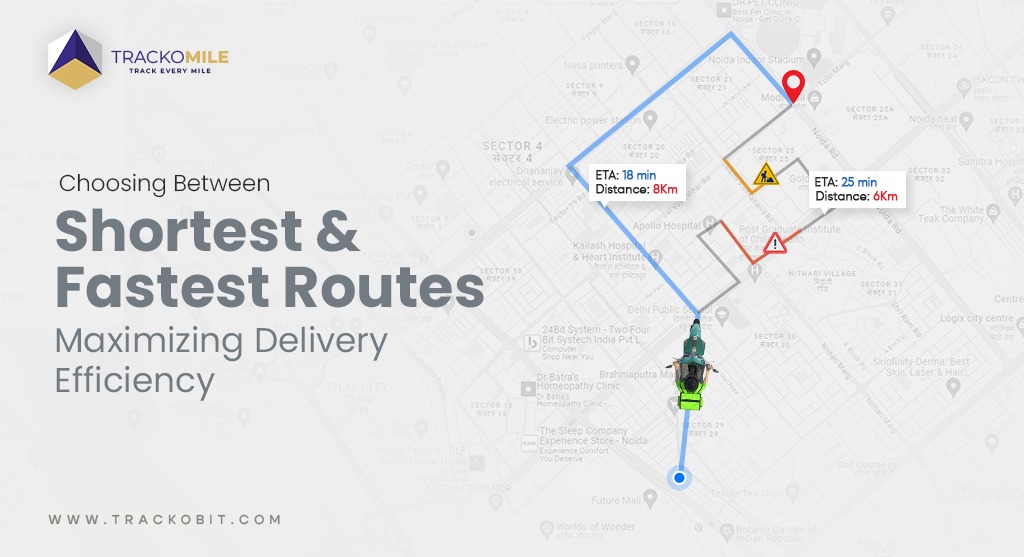
Confused as to which route is the best for your delivery business – the shortest route or the fastest route? Here is a guide to helping you make the right choice!
Table of Contents
Toggle
Last-mile delivery businesses desperately trying to strike a balance between customer satisfaction, on-time delivery, and economical delivery often ask: which route is the best—shortest or fastest?
Imagine you have to make urgent deliveries and you have two routes in from you:
Route A – Total distance is 8 km, but the travel time is just 18 minutes
Route B – Total distance is 6 km, but the travel time is 30 minutes
Well, which route would you choose from the above two? It’s not easy to decide, right?
Be it the fastest route or the shortest route, both have pros and cons attached to them. It’s not easy to choose between these two routes, and the decision often depends on the following parameters:
- Delivery window (how urgent is it to deliver a good?)
- Drivers’ schedule (important to ensure so that you won’t have to pay them overtime)
- Operational costs (Can operating hours and time on the road be reduced to save on fuel expenses?)
Read this blog to figure out which route is best for your business:
- Shortest route- which reduces distance
- Fastest route – which prioritises speed.
What is the Shortest Route?
The shortest path, either on a map or over the road network, is the one that travels the least distance between two points. Based on the actual location, this is the quickest route between the two sites. The shortest route method is frequently used in transportation, logistics, and mapping navigation to find the most efficient way to the destination while covering the least amount of ground on the journey.
However, additional factors like speed limits, traffic jams, and poor road conditions could prevent you from always taking the fastest route. This could impact how long it takes to travel the shortest way. Therefore, a faster route may result in fewer distances on the map.
Nonetheless, this may not necessarily be the shortest in terms of travel duration.
What is the Fastest Route?
The fastest route shows the shortest path between two points. It accounts for every factor that affects travel time, such as speed limits, traffic congestion, and road conditions. The goal should be to get to the destination in the least amount of time, even if that means occasionally taking the longer route rather than the one shown by the map. In an effort to arrive at their destination as soon as feasible, travellers search for the fastest route available.
The dilemma of perpetual travel is between the shortest and fastest routes. The fastest path prioritises speed over distance, even though the shortest route decreases both. This blog investigates the factors that affect your decision-making process and what makes these pathways good or terrible choices for you. See how real-time data and technology combine to guarantee optimised trips that strike a balance between time and efficiency.
Shortest Route: Pros and Cons
Advantages of the Shortest Route:
- Reduced Mileage: The shortest path reduces the overall distance travelled. As a result, the vehicle not just shrinks your mileage, causing less wear and tear to the operating vehicles and increasing their longevity.
- Fuel Consumption Savings: Reducing the distance by one inch conserves fuel and money and aids in environmental preservation. By lowering the costs businesses face while operating a fleet of cars also helps to cut pollution levels.
- Time Efficiency: This shortcut route is typically the best, quickest, and most suitable option when you are looking for better time management. This is crucial, particularly for supplies that must be made on time to ensure faster deliveries and content customers.
- Resource Optimization: Businesses that choose the quickest route can optimise their resource allocation (like drivers’ and vehicles’) sparingly, which helps improve operational and delivery efficiency.
Disadvantages of the Shortest Route:
- Road Conditions: Your delivery rider might use poor-quality roads, which are uneven and even unsafe at most times, to navigate the shortest route. These circumstances risk your delivery agents’ safety and negatively influence your vehicles’ lifespan.
- Congestion: Selecting the shortest route may force cars to pass through congested areas during rush hours. The reduced distance, meanwhile, might eventually lead to substantially longer travel times and nullify the time-saving advantages.
- Unpredictable Delays: Road closures, accidents, or unanticipated detours may occur along the shortest route. This could result in a longer delivery time.
- Complex Routes: Short routes are often complex routes, These are winding routes with many corners, intersections, and possibly complicated instructions. They may also lead to navigation difficulties or even wrong turns.
- Safety Concerns: Safety issues may arise when choosing the shortest route, as this might cut through fewer inhabited and poorly lit areas, becoming a great concern at night.
Fastest Route: Pros and Cons
Benefits of the Fastest Route:
- Time Efficiency: The fastest route significantly reduces travel time as its main benefit. This is especially important in situations with deadlines, such as for time-sensitive deliveries or urgent at-home appointments (maybe for caregiving service).
- Traffic Avoidance: Opting for the fastest route enables drivers to navigate around areas with heavy traffic congestion. This has the potential to result in smoother journeys and reduced frustration for both drivers and consumers.
- Predictable Arrival Times: By selecting the fastest route, one can help businesses, consumers, and individuals plan ahead by obtaining more precise arrival time predictions.
- Reduced Stress: Reduced travel time and more convenient routes help drivers feel less stressed since they drive less and deal with fewer traffic-related issues.
- Increased Productivity: Faster routes for businesses translate into quicker delivery turnaround times, which can improve overall operational effectiveness and customer satisfaction.
Cons of the Fastest Route:
- Longer Distance: In certain cases, avoiding traffic requires taking longer routes and detours than the fastest path. This could entail travelling a greater distance.
- Fuel Consumption: Faster routes could require stopping and starting more frequently or burning more gasoline when operating in high gear.
- Environmental Impact: Choosing the fastest routes increases fuel use, endangering the environment by raising pollution levels.
- Navigation Errors: Taking the fastest route can lead to overspeeding, which can further lead to unexpected detours onto unfamiliar roads, resulting in numerous navigational mistakes.
- Safety Concerns: Faster routes might pass through dangerous or congested areas, which puts the safety of the drivers and passengers at risk.
- Unforeseen Delays: Despite following the fastest route and having adequate planning, unexpected occurrences, such as closed roads or risks of accidents c can happen.
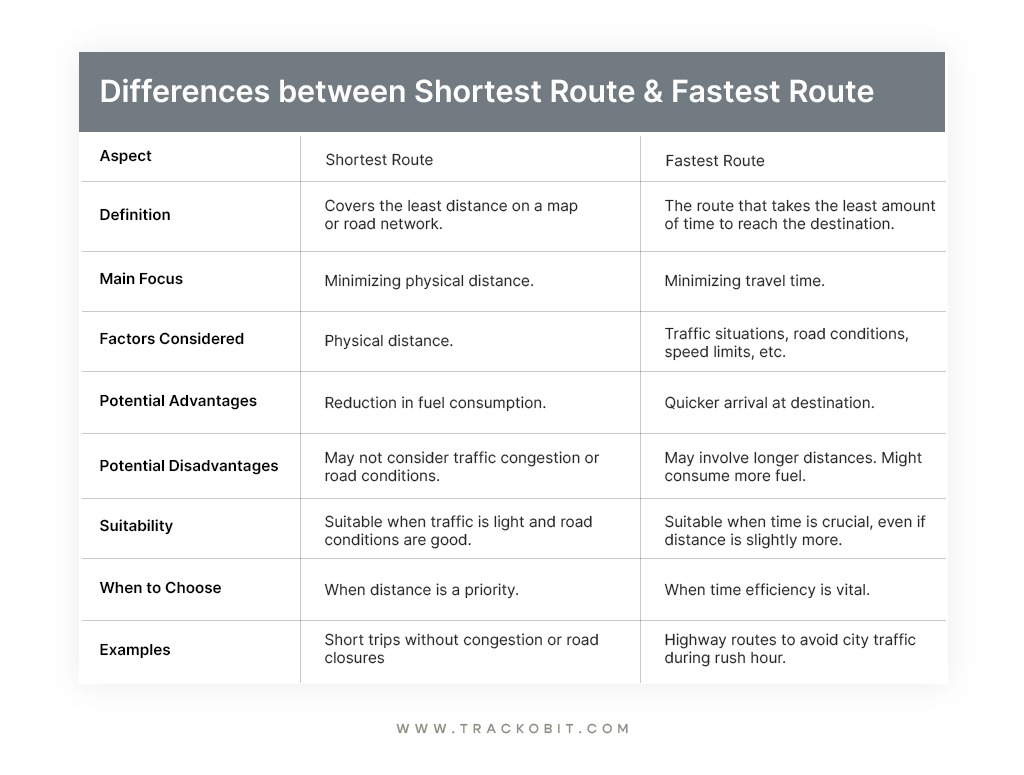
Shortest vs. Fastest Route: Which is the Best Choice For Your Last Mile Delivery Business?
In the delivery industry, various factors are considered while deciding between the fastest and shortest routes. These include the company’s objectives, client expectations, operational effectiveness, vehicle size, and the kind of goods being transported. There are also the benefits and drawbacks of every strategy.
Ideal Choice for Delivery Business:
Still, a combination of quickest time and shortest distance would be the optimal compromise for around 90% of delivery services. Using route optimisation software with up-to-date traffic data, road conditions, delivery window timings, and vehicle load limits, might be balanced.
- For routine deliveries: There are several benefits to using the shortest route, including meeting delivery deadlines, increasing customer satisfaction, and achieving company goals.
- For long-term cost savings: In the long run, concentrating on the fastest route may result in lower operational and corporate costs by reducing fuel use and vehicle abuse.
In conclusion, the ideal choice should carefully balance the delivery company’s aims, client needs, and logistical difficulties.
TrackoMile’s Route Optimisation Solution – Solving the Dilemma
TrackoMile is sophisticated last-mile delivery software offering route optimization solutions that let you choose the most optimised routes, reducing your hassle of deciding between the fastest and shortest routes. The solution is efficient enough to suggest the best-suited route for the delivery, and that too in seconds. The route considers 120+ factors and automates stop sequencing for multiple routes. Thai adds to the efficiency of the suggested route. Here are some factors and features that make TrackoMile’s route planning software world-class.
Real-Time Data Integration: TrackoMile can be integrated with real-time traffic data sources to monitor traffic updates, delays, and road congestion in real-time. This gives us an idea of how traffic is moving over the stage.
Delivery Windows: It uses the delivery window selected by a customer or any other operational restrictions. It determines the shortest route, considering both the short duration and scheduled delivery times of respective goods.
Historical Data: The last-mile delivery solution may examine historical route data, identifying trip times and traffic conditions trends. This helps in understanding typical traffic patterns and forecasting different times of day.
Customer Priority: It also allows for recognising or considering specific client concerns. Consider the scenario where TrackoMile recommends the quickest route to guarantee prompt delivery of a high-priority customer.
Distance Constraints: Calculating the distance between the shipment’s origin and destination may be helpful. This may refer to the quickest path with the least traffic and a small distance.
Vehicle Type and Capacity: You can also optimise routes depending on the type of vehicle assigned for delivery and its load capacity. Weight restrictions and other legal constraints should be considered when creating such optimised routes.
Dynamic Adjustments: The solution can track real-time traffic updates throughout the trip. If the chosen path has heavy traffic or even a road shutdown, it might suggest a quicker alternative.
Delivery Urgency: Route optimisation software can choose the fastest route for shipments that need to arrive quickly while also considering other factors.
Operational Cost Analysis: Businesses may choose the optimal balance between speed and cost thanks to the platform’s estimation of the identical fuel-based costs for the fastest and least expensive routes.
Customizable Preferences: The business can choose to set up their preference for route optimization by selecting the compromise they need between speed.
Conclusion
Businesses may find it challenging to decide between the fastest and shortest route because each has its own advantages. So, you can choose one based on your business needs. The best route ultimately depends on several variables, such as the nature of the business, the delivery method, and the particulars of each journey.
Companies can use TrackoMile’s route optimization software to expedite this decision-making process. It provides the optimal routes after taking into account all pertinent factors. Reliable last-mile delivery software can help firms save money, increase productivity, and enhance their overall performance.
Businesses must periodically assess and adjust their distribution routes to continue operating at optimum efficiency and profitability. By implementing the appropriate tactics and tools, businesses may improve customer happiness, optimize processes, and remain competitive.
Frequently Asked Questions
-
What is the difference between the shortest and fastest route?
The significant difference between the shortest route and the fastest route is that the shortest route is the one that covers the least amount of distance, whereas the fastest route is the one that takes the least amount of time to reach the destination.
-
Is the fastest route the same as the shortest route?
No, both the fastest route and the shortest route are different. The fastest route aims to reach the destination as fast as possible irrespective of distance or fuel consumption. While in the shortest route, the aim is to take a route that covers the least distance irrespective of time.
-
Which is better – the fastest route or the shortest route?
The decision between the fastest and shortest route depends on your businesses’ requirements and constraints. The fastest route would be useful if time is the most important factor. The shortest route will be preferable if saving money on fuel or minimizing vehicle wear and tear is more important. In cases where there’s a need to strike a balance between both, using a route planning tool is preferred because it provides a variety of route possibilities along with expected travel times and distances.
-
What are the benefits of the shortest route?
The benefits of the shortest route include reduced fuel consumption, reduced vehicle wear and tear, improved productivity, and reduced carbon footprint.
-
What are the benefits of the fastest route?
The benefits of the fastest route include reduced travel time, improved customer satisfaction, increased productivity, and reduced labor costs.
Tithi Agarwal is an established content marketing specialist with years of experience in Telematics and the SaaS domain. With a strong background in literature and industrial expertise in technical wr... Read More
Related Blogs
-
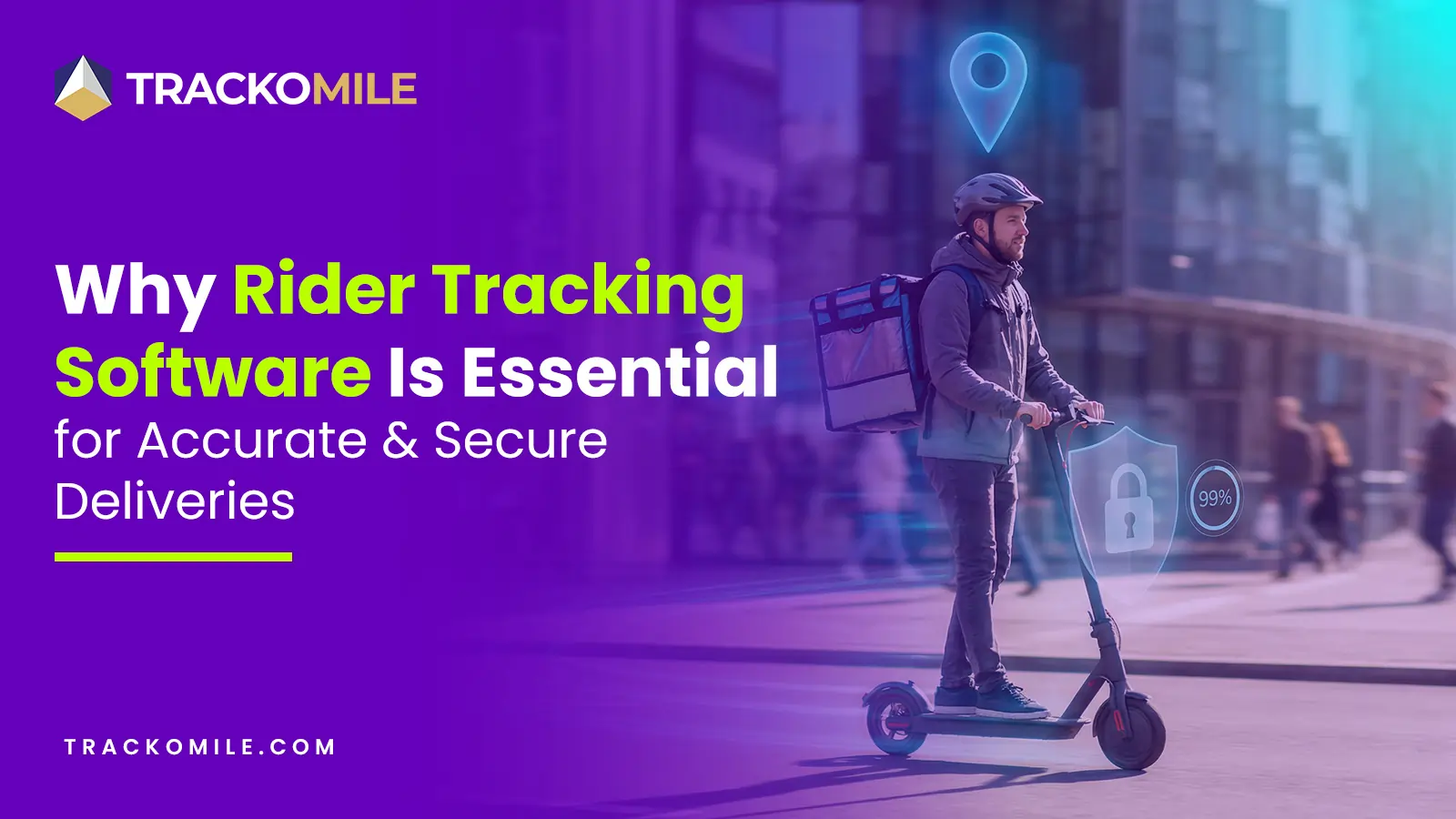
How Rider Tracking Software Improves Delivery Accuracy and Reduces Fraud
Tithi Agarwal December 8, 2025Rider tracking software improves delivery accuracy with real-time GPS visibility and automated ePOD. It also enables route optimisation and fraud…
-
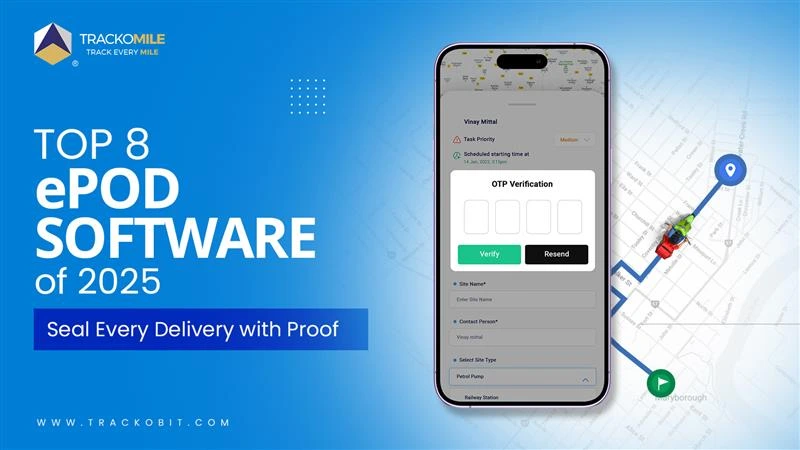
Top Electronic Proof of Delivery (ePOD) Software in 2025
Tithi Agarwal September 25, 2025Electronic proof of delivery has become the backbone of modern logistics. Explore the top 8 ePOD software in 2025 and…
-
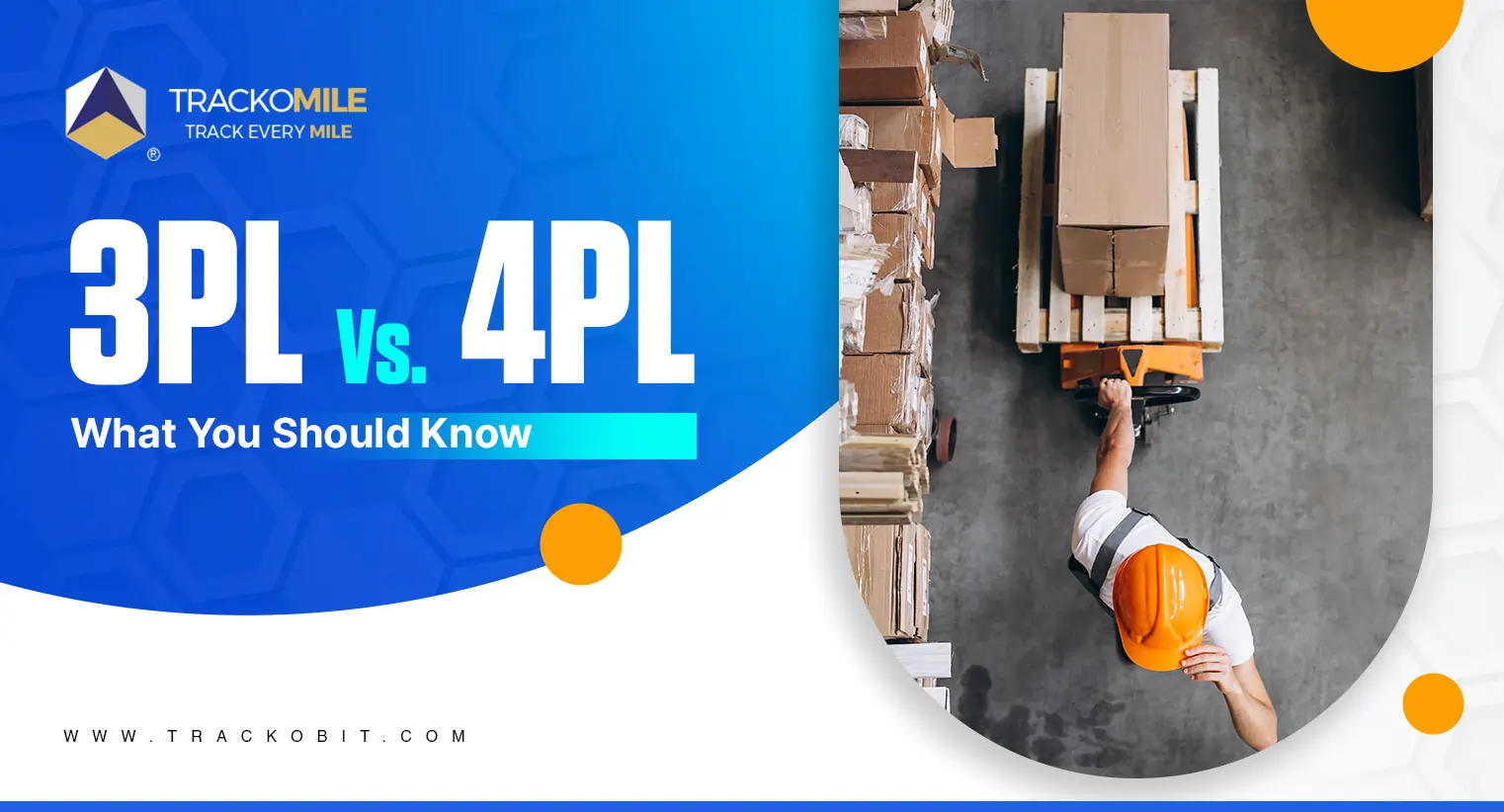
3PL vs. 4PL: Which is Best for Your Business?
Tithi Agarwal September 25, 2024Confused about choosing between 3PL and 4PL for your retail supply chain? Read this blog to find out which is…
-
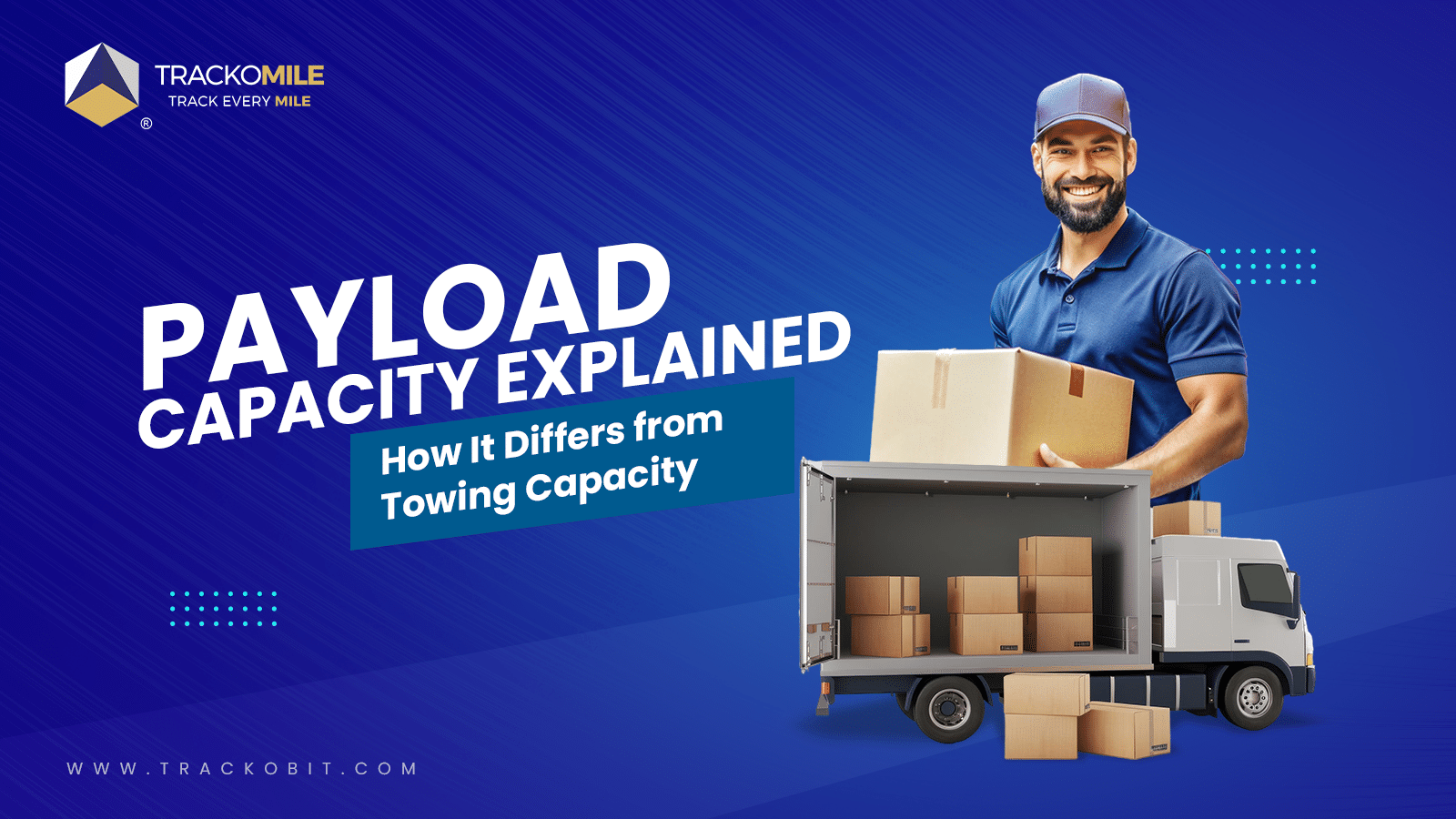
What is Payload Capacity? Payload Capacity Vs. Towing Capacity
Tithi Agarwal September 10, 2024Payload capacity is the total weight a vehicle can safely carry, and it is crucial for safety and compliance. Exceeding…

Subscribe for weekly tips to supercharge your last-mile delivery.
Your inbox awaits a welcome email. Stay tuned for the latest blog updates & expert insights.
"While you're here, dive into some more reads or grab quick bites from our social platforms!"Stay Updated on tech, telematics and mobility. Don't miss out on the latest in the industry.
We use cookies to enhance and personalize your browsing experience. By continuing to use our website, you agree to our Privacy Policy.



































